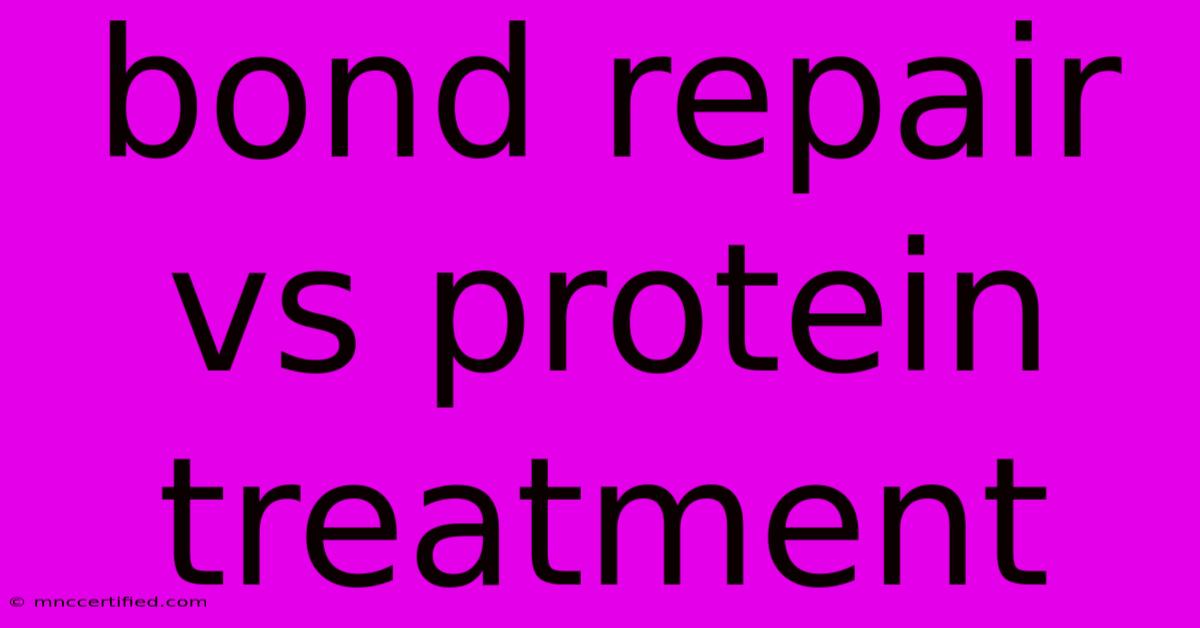Bond Repair Vs Protein Treatment

Table of Contents
Bond Repair vs. Protein Treatment: Which is Right for Your Hair?
Damaged hair. We've all been there. Whether it's from heat styling, coloring, or just the general wear and tear of daily life, our locks can take a beating. But with so many hair repair products on the market, choosing the right one can feel overwhelming. Two popular options often leave people confused: bond repair and protein treatments. This article will break down the key differences between these two powerful hair treatments, helping you determine which one—or even if a combination—is best for your specific hair needs.
Understanding Hair Damage: The Building Blocks
Before diving into treatments, let's understand what constitutes hair damage. Hair is primarily made of a protein called keratin, arranged in a complex structure of bonds. These bonds, including hydrogen, salt, and disulfide bonds, contribute to hair's strength, elasticity, and overall health. Damage occurs when these bonds are broken, leading to:
- Increased porosity: Hair becomes more absorbent, leading to dryness and frizz.
- Loss of elasticity: Hair becomes brittle and prone to breakage.
- Rough texture: The hair cuticle becomes damaged, resulting in a dull, lackluster appearance.
- Split ends: The hair shaft frays at the ends.
Bond Repair Treatments: Rebuilding the Foundation
Bond repair treatments, often containing ingredients like amino acids or bonds builders, focus on reconnecting broken bonds within the hair shaft. They work at a molecular level to mend the internal structure of the hair, strengthening it from the inside out. These treatments are excellent for hair that has undergone significant damage from chemical processes like bleaching, perming, or relaxing.
Benefits of Bond Repair Treatments:
- Significant strength restoration: Repairs broken bonds for stronger, more resilient hair.
- Improved elasticity: Helps hair stretch and return to its original shape without breaking.
- Reduced breakage: Minimizes split ends and breakage from styling or combing.
- Suitable for chemically treated hair: Ideal for repairing damage caused by bleaching, coloring, and other chemical processes.
Popular Bond Repair Ingredients:
- Bis-Aminopropyl Diglycol Dimaleate: This ingredient is a common bond builder found in many professional bond repair treatments.
- Maleic Acid: Another popular ingredient known for its bond-building capabilities.
Protein Treatments: Adding Strength and Structure
Protein treatments, conversely, work by adding protein to the hair shaft, essentially replenishing what has been lost due to damage. These treatments temporarily coat the hair, making it feel thicker, smoother, and stronger. They're particularly beneficial for hair that is fine, weak, or lacks body.
Benefits of Protein Treatments:
- Increased strength and thickness: Adds volume and body to fine or limp hair.
- Improved elasticity: Helps hair become more resilient to breakage.
- Smoother texture: Can reduce frizz and improve manageability.
- Suitable for various hair types: While effective for damaged hair, they can also benefit healthy hair in need of added volume and strength.
Popular Protein Sources in Hair Treatments:
- Hydrolyzed keratin: A broken-down form of keratin that is easily absorbed by the hair.
- Soy protein: Provides a boost of protein and moisture.
- Wheat protein: Adds strength and elasticity.
Bond Repair vs. Protein Treatment: A Head-to-Head Comparison
| Feature | Bond Repair | Protein Treatment |
|---|---|---|
| Mechanism | Repairs broken bonds within the hair shaft | Adds protein to the hair shaft |
| Best for | Severely damaged, chemically treated hair | Weak, fine, or limp hair; needs added body |
| Results | Stronger, more elastic, less breakage | Thicker, smoother, more manageable hair |
| Frequency | Less frequent (every 4-6 weeks) | More frequent (every 1-2 weeks, depending on needs) |
Choosing the Right Treatment: The Perfect Blend
The best choice depends on your hair's specific needs and level of damage. For severely damaged hair, a bond repair treatment is often the first step, followed by protein treatments to further strengthen and improve manageability. Some people even benefit from alternating both treatments. It's always best to consult with a professional stylist for personalized advice based on your hair type and condition.
Remember that proper hair care extends beyond just treatments. Minimizing heat styling, using sulfate-free shampoos and conditioners, and protecting your hair from the sun are all essential steps in maintaining healthy, beautiful hair. By understanding the differences between bond repair and protein treatments, you can make informed decisions to achieve your hair goals.

Thank you for visiting our website wich cover about Bond Repair Vs Protein Treatment. We hope the information provided has been useful to you. Feel free to contact us if you have any questions or need further assistance. See you next time and dont miss to bookmark.
Featured Posts
-
Old Forester 117 Bottled In Bond
Nov 20, 2024
-
Cold Weather Payment Full Postcode List
Nov 20, 2024
-
Top 25 Marquette Beats Purdue
Nov 20, 2024
-
Gibbon Fiberglass Bodies By Bond
Nov 20, 2024
-
Drawing Covalent Bonds Worksheet
Nov 20, 2024